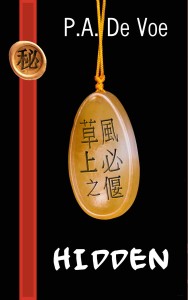 Relevant History welcomes P.A. De Voe, an anthropologist, Asian specialist, and incorrigible magpie for collecting seemingly irrelevant information. Her first published mystery, A Tangled Yarn, is a contemporary cozy. In her current writing, however, she has jumped back in time and place, immersing her stories in the Ming Dynasty. She’s published several historical short stories, From Judge Lu’s Ming Dynasty Case Files, in anthologies and online. Her newly published adventure/mystery YA trilogy (Hidden, Warned, and Trapped) takes place in 1380 A.D. China. To learn more about P.A. De Voe and her books and to get a free short story, visit her web site.
Relevant History welcomes P.A. De Voe, an anthropologist, Asian specialist, and incorrigible magpie for collecting seemingly irrelevant information. Her first published mystery, A Tangled Yarn, is a contemporary cozy. In her current writing, however, she has jumped back in time and place, immersing her stories in the Ming Dynasty. She’s published several historical short stories, From Judge Lu’s Ming Dynasty Case Files, in anthologies and online. Her newly published adventure/mystery YA trilogy (Hidden, Warned, and Trapped) takes place in 1380 A.D. China. To learn more about P.A. De Voe and her books and to get a free short story, visit her web site.
*****
It was ancient China’s inherently different approach to law—based on morality and collective responsibility—compared to our contemporary approach—based on written law and individual rights—that has interested me for a long time. This interest led to my writing crime novels and short stories set in 14th- and 15th-century China. In my Ming Dynasty trilogy and Judge Lu short stories, I often highlight different parts of how the traditional Chinese judicial system worked as well as its implications for the entire family and community.
Justice and law
Traditionally, people believed a criminal’s behavior threw the world into a moral imbalance. And this imbalance had to be righted by not only bringing the criminal to task for his crime—and thereby bringing justice to the victim—but also by that criminal taking moral responsibility for his crime.
We can think of this view of crime as each individual being a brick upon which the health and well-being of the community and even the nation was built. As a result, it was not the individual but the community, the society, which was important.
The role of the magistrate
The magistrate was the centerpiece of the Ming Dynasty’s legal system. A magistrate was chosen among the best and brightest in the country. He had passed the all-important national examinations at the highest level. Once assigned to the office of magistrate, he remained in any one location for only three years at a time. This limited time frame was designed to keep him from becoming too close to the local power structure and thereby subverting his ability to do his law-enforcing job fairly.
And his job was formidable and multifaceted: he was the investigator, prosecutor, and judge all rolled into one. Because of his position’s tremendous power, the government required full documentation of the cases that came before the court. During the investigation, every detail had to be recorded. Examinations of witnesses were open and transparent, taking place in public and written up by the court secretary. The law mandated a timetable for bringing each case to a successful resolution—that is, to getting an admission of guilt by the alleged criminal.
Admission of guilt
It was critical for the criminal to admit his guilt. Simply finding rock hard evidence against him was not enough. An accused could not be legally found guilty and given a sentence if he did not admit to having committed the crime. This was because by admitting guilt he took responsibility for the crime and thereby restored moral order in the community and the universe.
Collective responsibility
Once found guilty, the criminal was not the only person who could and would be punished. Because of the notion of collective responsibility, members of his family could also be punished—or at least held accountable at some level. If a man, for example, committed a crime, his family was considered partly responsible for his behavior and, therefore, the crime. If his father was alive, the father could receive an even more severe punishment than his son because the father was ultimately responsible for his son’s behavior.
The legal use of torture
This, of course, raised the problem of how to get a criminal to admit guilt, which in the case of serious crimes, could lead to the death penalty, exile, or military service—which was at the borders of the country and often meant a life of severe hardship. Because, as I said, even unquestionable evidence against the criminal was not enough, the answer to how to get a man to admit guilt was the use of moderated torture. The court applied various levels of torture. The law strictly defined the type and degree of torture not only allowed, but often expected. While the use of torture could be used in bringing about a confession, a magistrate’s use and potential abuse of torture was closely monitored by the government. How was this done?
Monitoring judicial practices
Whenever a serious crime was committed—with the penalty, therefore, being equally serious—all of the court documents had to be sent up through the various levels of the judicial process until it reached the emperor’s office. If any impropriety was found—in the investigation, in the treatment of the alleged criminal, or in the punishment assigned—the magistrate was held culpable. This resulted in an investigation of the magistrate and his handling the case. If found guilty of maleficence, the magistrate could receive the punishment he had given the alleged criminal—including the death penalty! Plus, he and his family could lose all of their property. Again, under the concept of collective responsibility, his family was punished along with him—at a lesser level but still punished.
Such a system may seem overly harsh; however, its objectives were to 1) bring justice to victims of crimes; 2) make the criminal (and his relevant family members) take responsibility for his crime; and 3) return moral order to the community and, thus, the universe. How this all played out in the lives of people is what fascinates me and what I hope intrigues my readers.
*****
 A big thanks to P.A. DeVoe. She will give away a paperback copy of Hidden to someone who contributes a comment on my blog this week. I’ll choose the winner from among those who comment by Friday at 6 p.m. ET. Delivery is available worldwide.
A big thanks to P.A. DeVoe. She will give away a paperback copy of Hidden to someone who contributes a comment on my blog this week. I’ll choose the winner from among those who comment by Friday at 6 p.m. ET. Delivery is available worldwide.
**********
Did you like what you read? Learn about downloads, discounts, and special offers from Relevant History authors and Suzanne Adair. Subscribe to Suzanne’s free newsletter.

The concentration of power and responsibility in one person seems risky, even with controls. Moving the magistrate around must have helped. I suspect it worked better in small communities than large ones. I’m looking forward to reading the copy of Hidden that I bought yesterday.
The torture is chilling. Was it considered a deterrent to crime?
It was fun seeing you this weekend, Carolyn!
You’re right when you suggest that such concentration of power and responsibility was risky. The ramifications of this is something I haven’t been able to deal with in a short story, but I’m hoping to delve into as I begin a new series. It takes a longer format than a short story allows to be able to develop this issue.
From what I can tell, torture was not necessarily in itself a deterrent to crime. Probably the element of collective responsibility held most people in check–or at least gave them pause when they considered breaking the law.
Hello Carolyn,
I love this point of Chinese history and have placed your book on Goodreads as a Must Read.
Hi, D.J. —
Yes, the fun we all have in historical fiction is the research! Glad you enjoyed the post.
This is a fascinating look at how different cultures look at the concept of justice. I definitely want to read more!
Hi, Ashley —
You actually put your finger on an important difference that we don’t often think about: the concept of justice. What is justice after all? Such a basic concept for law and how law is applied.
I’ve enjoyed reading your Judge Lu short stories in several anthologies. Looking forward to this new YA series. We met briefly at B’con 2015 but don’t expect you (or Suzanne) to remember since it was all a busy blur.
Karen —
I’m honored that you’ve read & remember my Judge Lu stories. Bouchercon 2015 was such an amazing event. And, of course, your own short story in the Murder Under The Oaks anthology was especially interesting to me.
Thanks for stopping by!
I’ve long been a fan of Van Gulik’s Judge Dee stories, and its nice to find another historical mystery series set in China, if a somewhat later period. I look forward to giving them a try!
Yes, Robert van Gulik’s Judge Dee stories are wonderful. They represent the kind of crime stories the Chinese magistrates themselves liked to write throughout history. As you know, van Gulick’s original Judge Dee stories were translations of detective and crime stories he found in China. I think of these old Chinese stories and their authors–past magistrates–as models and mentors.
We have had discussions about the use of torture and what constitutes torture in the USA. I think the idea of reviewing judgments and holding the judges responsible is intriguing. Thanks for sharing your work.
Hi, Warren —
Interestingly enough in a wonderful resource I have–a magistrate’s manual–the magistrate was cautioned to be careful in the use, type, and even the degree of the torture being implemented. Also, the effectiveness of torture in getting at the truth was also an on-going discussion. Much, as you say, it is today.
This is a fascinating look at the traditional Chinese system, and it explains at least to me where the North Korean government got the idea of punishing the family for the crimes of an individual. I thought the idea was horrific when I first heard it, but I can see that it’s an accepted (?) part of their culture.
The concentration of power and responsibility in one person, regardless of the reviews by authorities higher up, seems very dangerous, and the use of torture self-defeating. Getting someone to confess hardly means he or she is guilty (but we know that). Still, this is a very useful look into another culture’s way of examining and dealing with crime.
Hi, Susan —
The ramifications of such a concentration of authority are fascinating. Something that is easier for us to say today from the distance of time and culture. I hope to be able to delve into some issues in a new mystery/crime series I’m writing, which will still be in the early Ming period.
The question of efficacy in the use of torture was one that concerned the traditional Chinese legal system, as well. That is why the magistrates were expected to do a thorough job in the investigation stage. Then, even after a complete investigation, the judge was still cautioned about how and what techniques to use–IF necessary. Age, gender, and infirmities were–BY LAW–considerations that also had to be applied in the decision to use torture in getting to a confession by the guilty.